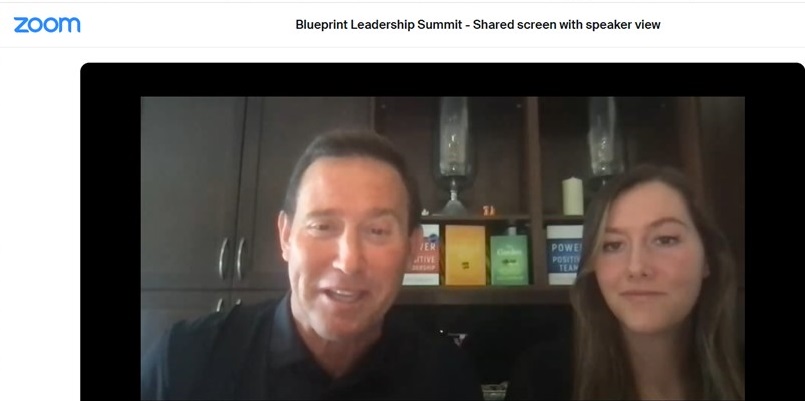This spring, ConantLeadership held our 5th biannual BLUEPRINT Leadership Summit—a weeklong meeting of top leadership minds and luminaries.
To kick off the week, ConantLeadership Founder & CEO Doug Conant hosted a conversation with Jon Gordon and Jade Gordon, father-daughter panelists who are teaching people how to use “positive leadership” to make a difference.
Jon Gordon is founder of The Jon Gordon Companies and author of many bestselling leadership books including, The Power of Positive Leadership; Jade Gordon is a keynote speaker and workshop leader for The Jon Gordon Companies; and Doug Conant is a world-renowned business leader, board director, and former CEO of Campbell Soup Company. Together, these three experts offer rich insight into how to use a positive message to inspire people and get results in a challenging world.
Enjoy the following recap and key takeaways from their conversation. (You can watch the video recording of this discussion here. Fast forward to roughly minute 6:40 to skip intros and housekeeping.)

Optimism > Pessimism
The three experts are unanimous: Pessimism is not the path to winning hearts and minds. Jon, who has been writing and speaking on the topic for decades, says leadership is a “transfer of belief,” from the leader to their team—and it requires optimism. To effect change, leaders must carry and convey this winning, can-do message: “We have the power today to transform our circumstance, to transform our situation, and overcome.” Then, as leaders move incrementally towards the promised transformation, positive change becomes a self-fulfilling prophecy, and the proof of concept spreads hope far and wide.
Doug, who has taught, practiced, and studied leadership for over 45 years, says pessimistic leaders do not deliver lasting results. While he admits that negative managers may “enjoy momentary success in the here and now,” they struggle to “create an enduring platform of success built around negative thought.” He’s observed that bosses who have “optimism embedded” in their ethos are the ones who leave a legacy.
Jade, who runs workshops on the principles of positive leadership, adds that mindset is key: “The world you see determines the world that you create.” She says leaders who default to negative perceptions will find it challenging to shift their culture.
Jon also stresses that the benefits of optimism extend beyond leadership to all areas of life: “Optimists work harder, get paid more, and are more likely to succeed in business and sports,” and because they believe in “a better and brighter future,” they are more likely to take the necessary steps to bring their dreams to fruition—for themselves and for their organizations and communities. It’s not that optimism is a magic trick; it’s that optimists take action.
Start from the Inside Out
If optimistic leaders are the most prolific and productive, what’s their secret? How do they leverage their upbeat disposition to create positive breakthrough?
Our three experts say the answer is simple (but not easy): It starts from within. To inspire confidence, leaders must be anchored in who they are and what they believe. Then they can communicate their vision from a clear and compelling position of strength.
Jon says: “You have to understand that the power is inside of you. We always create from the inside out, not the outside in.” Competence and grace under pressure are internal drivers that extend outward from your character. He says, “when you know your values, you show your values,” and decision-making gets easier. Jade adds that it’s about learning to lead yourself first to get in a “headspace that can then lead other people in a positive way.”
Doug builds on the power of self-knowledge. In a complex world rife with disarray, leaders must find inner fortitude. He shares that he created The Blueprint to provide a practical process for leaders to “get grounded in their core beliefs,” drawing from their own experiences, so they can stand firm no matter the mayhem: “We believe your life story is your leadership story. You just have to get in touch with it.” And he adds: “You can’t have the courage of your convictions if you don’t know what your convictions are.” The brave leader is buoyed by belief. And belief requires introspection.
Once leaders feel connected to their beliefs, value, and purpose—they can be bold, direct, and transparent. Doug says leaders must be explicit about their own vision and the shared mission for the organization: “Clarity is next to godliness. When it’s clear, everyone can engage in the work.” Jon adds, “the more you provide clarity—that leads to focused action,” especially when you connect employees’ contributions to the purpose and mission: “When you know your why, you’ll know the way, and you won’t let obstacles get in your way.” Change starts with you.
Lead with Empathetic Listening
While the panelists champion a hopeful outlook, they also warn that optimism and self-understanding without empathy is insufficient. In a chaotic world with urgent issues, some leaders worry that a strictly sunny leadership proposition could minimize problems. Jon says, “so many are struggling with negativity, adversity, and challenges,” and they are rightly dubious about “fake positivity.” Others worry about how positive leadership might morph into “toxic positivity,” which is a damaging workplace pressure to only display or discuss positive emotions and suppress the full range of human expression.
Reassuring doubters, Jon clarifies that positive leadership, “is not about seeing the world through rose-colored glasses,” or “ignoring reality,” but rather it’s an uplifting approach that equips people with “the power to overcome the thorns.” He says that positive leaders should not gloss over people’s negative feelings, and instead must, “meet people where they are and listen, empathize, be there for them, show them you care.”
Jon explains that caring is one of four crucial components to leadership mastery that he calls the “4 Cs”—
- Communication
- Connection
- Commitment
- Caring
Ensuring people feel heard is essential across all 4 Cs because, Jon says, “you will never have commitment without connection,” and, “if you want a committed team, you have to become a connected team.”
Doug builds on the 4 Cs, citing research on employee engagement which shows that quality connections are key to retaining talent. He says, “people join a company and they leave a manager.” You must develop relationships “that transcend the ordinary” in order to grow tight-knit teams and deliver high performance. And Jade backs this up, reminding leaders that employees are less likely to quit if they know their boss has their best interests at heart.
Doug frames the need for better relationships in the context of today’s evolving landscape: The business world has shifted from a VUCA environment (Volatile, Uncertain, Complex, Ambiguous) to a BANI environment (Brittle, Anxious, Nonlinear, Incomprehensible) which is even more confounding than before. He says when confusion is rampant, “leading by listening” becomes crucial: “As anxiety goes up, it demands more empathetic listening,” and tuning in to both “what’s being said and not said.” Listening may seem simple, but many executives don’t do it well, and Doug says it is a top priority: Today, “the soft stuff is the hard stuff,” and the leaders who will prevail in the future are the ones who can “build relationships and create cultures of caring and support.”
The panelists agree: When constituents express concerns or grapple with thorny issues, the role of the leader is not to downplay suffering or sweep complications under the rug. Leaders must listen with empathy, acknowledge obstacles, and then position themselves as problem-solvers, bringing stakeholders along with them to improve conditions together.
Be Like the Coffee Bean
Our experts expand their discussion on how the world has changed and what it demands: They say COVID revealed the importance of adaptability and resilience. Leaders who have a sturdy foundation of self-knowledge listen better, bounce back from setbacks quicker, and are more likely to use positive leadership to make a difference. Jon shares the central metaphor from his book The Coffee Bean, co-authored with Damon West. He says to consider how three different objects react in boiling water:
- An egg—becomes hardened by hot water
- A carrot—becomes softened by hot water
- A coffee bean—transforms the hot water into coffee
Leaders have a choice in the face of adversity. They can become hard, bitter, and angry like the egg. They can become weakened, fearful, and anxious like the carrot. Or they can transform their environment like the coffee bean; they can change the world for the better rather than letting the world change them for the worse.
Jon sums it up this way: “As a positive leader, you’re able to define your situation. You rally your team towards a brighter and better future,” no matter how hot the water gets. And the panelists are united on how to be that rallying steward: Serve your stakeholders with optimism, start your transformation from within and extend it outward, lead your associates with empathetic listening, and meet an ever-dynamic world with the resilience of the coffee bean—turning obstacles into opportunities.
____
Enjoyed these insights? Find Doug’s past #BLUEPRINTSummit conversations with top thought leaders like Brené Brown, Bill George, Amy Edmondson, Indra Nooyi, Dan Pink, Susan Cain, and more in our video library. And find blog recaps of past summit discussions in our resources here: https://conantleadership.com/blog/
 About the author: Amy Federman is ConantLeadership’s Director of Content and Editor in Chief, and co-author with Doug Conant of the WSJ bestseller, The Blueprint.
About the author: Amy Federman is ConantLeadership’s Director of Content and Editor in Chief, and co-author with Doug Conant of the WSJ bestseller, The Blueprint.
(Cover photo by The CEO Kid on Unsplash)






0 Comments